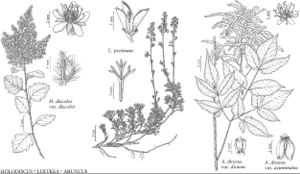Aruncus
Opera Var., 259. 1758.
Herbs, perennial, clump-forming, 5–15 (–20) dm, herbage glabrous or sparsely to densely hairy, hairs simple, straight to curved, sometimes multicellular or glandular; rhizomatous, rhizomes thick, branching, woody; roots coarse, fibrous. Stems 1–5, erect, stout, simple, sometimes glaucous. Leaves deciduous, cauline, alternate, 2–3-irregularly ternate to odd-pinnate, equivalent to 2–3 pinnate; petiole present, relatively long, base 1/2 sheathing stems; blade broadly ovate, cauline reduced in size and complexity distally, 15–60 cm, thick to thin, leaflets 9–45, long-petiolulate, broadly ovate to narrowly lanceolate, margins flat, [serrate to] doubly serrate, venation pinnate. Inflorescences terminal, 500–2500-flowered, racemes forming panicles; bracts present; bracteoles present hairs simple, glandular. Pedicels present. Flowers unisexual (plants dioecious, rarely polygamous), 3–4 mm diam.; epicalyx bractlets 0; hypanthium shallowly bowl-shaped, 0.5–1 mm, nectary ring inside with simple, glandular-hairs; sepals persistent, 5, spreading, triangular, margins entire; petals 5, white, obovate to elliptic, base cuneate; staminate: stamens (15–) 20 (–30) in 1 series (between calyx and nectar ring), longer than petals; torus minute; pistillate: nectar ring scarcely developed, stamens rudimentary, carpels 3, free, glabrous, styles terminal; ovules 2–4. Fruits follicles, 3 (or 4), pedicels recurving, fruits inverted, retrorse, ovate-elongate, 1.5–5 mm, shining, glabrous, dehiscent along whole adaxial suture; hypanthium persistent; sepals persistent, spreading to appressed; styles persistent, forming a beak. Seeds 2–4, elongate, membranous, caudate at both ends, scalariform-reticulate, seed-coat loose. x = 7, 9.
Distribution
North America, Eurasia, temperate regions
Discussion
Species 1.
Selected References
None.
Lower Taxa
"thick" is not a number. "thin" is not a number."thick" is not a number."dm" is not declared as a valid unit of measurement for this property.
